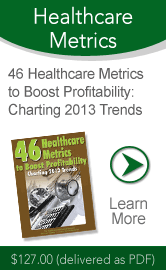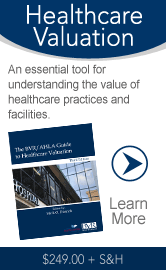 |
 |
Issue #14-1 | July 4, 2013

|
Healthcare finance execs see reform squeezing bottom lines Although health reform will create millions of newly insured patients, many healthcare finance executives do not expect this to be a shot in the arm for their bottom line. That means looking to other ways to improve financial performance. An article in HealthLeaders Magazine says that, while health reform and the creation of health insurance exchanges may sound good on paper, many hospital finance administrators are not convinced that all this will benefit providers—so they are bracing to take a hit to the revenue cycle. One of the finance execs worried about this is Marlene Zurack, senior vice president of finance and CFO for New York City Health and Hospitals Corp., which serves 1.4 million people per year, 475,000 of whom are uninsured. "We are not sure whether our uninsured patients are going to be able to participate in the exchanges," Zurack told the magazine. "There are a lot of requirements that they might not be able to meet, and, also, there is the cost sharing." Regardless of how many more patients obtain insurance coverage, HHC is likely to lose revenue in the end, Zurack says, due to cuts being made to Medicaid's Disproportionate Share Hospital program, which distributes payments to qualifying hospitals that serve a large number of uninsured individuals. What to do: Much of the cost control efforts to date have centered around improving processes related to the delivery of care. We believe an untapped area for many healthcare providers lies in overhead functions such as finance, human resources, legal, risk and insurance, and real estate management. Look to process redesign, standardization, and workflow automation to trigger significant labor savings, especially in back-office operations such as finance and human resources. Also, consider shared services and outsourcing to unlock economies of scale. Four ways hospitals can cut equipment costsNew equipment is key to quality care, but the price tag creates huge financial stress for hospitals. In today’s world of cost cutting, it may seem impossible to do anything about the high costs of equipment replacement. Not so, says an article in Hospitals & Health Networks Daily, which gives some good ways to trim equipment replacement budgets. 1. Do an inventory. Conducting an annual inventory can uncover more assets than you think you have—15% or more, the article notes. One health system discovered through an inventory that some equipment did not need replacing, so it was able to reallocate $84 million in funds. 2. Segment a replacement plan. Break down the equipment replacement into segments, such as the equipment with the highest cost or highest priority, says the article. For example, a hospital with a well-known cardiac program should put heart monitors and defibrillators in a high-priority segment. 3. Understand workflow. To uncover excess capacity—or limited capability—hospitals must examine workflow. Improving workflow to achieve 65% utilization can significantly lower capital and operating expenses, the article states. 4. Beef up security. Cyberattacks on medical equipment and devices create a serious problem. Recently, the U.S. Food and Drug Administration urged healthcare facilities to introduce security controls, such as restricting unauthorized access to networks and medical devices and creating strategies for maintaining functionality during adverse events. Our two cents: Speaking of equipment, we advise that you carry out an audit of service contracts on equipment. Some healthcare organizations simply have too many service contracts, especially on equipment that's been pulled out of usage. Also, you may find you have multiple service contracts on the same piece of equipment—or on equipment you disposed of long ago. So after the asset inventory is completed and cleaned up, take a fresh look at the service contracts on the equipment you actually have in your possession. Huge risk exposure in ER EHR systemsNew electronic health record (EHR) systems in emergency rooms are triggering widespread treatment mistakes due to design flaws in the fledgling systems. System users, however, are subject to gag clauses in vendor contracts that ban any public comments about the problems, hampering any fixes. This is revealed in a new report from the American College of Emergency Physicians. The report says hospital administrators rushed to buy systems from major EHR vendors to get incentive payments from the government without fully considering their emergency departments. The report outlines common pitfalls seen in EHR systems, including communication failures, poor data display, wrong order/wrong patient error, and alert fatigue. What to do: The report lists several recommendations, directed at hospital ER personnel as well as EHR system vendors. They include appointing a “clinician champion” in the ED to lead a performance improvement group that should be multidisciplinary and meet regularly to communicate with ED and hospital leadership. There should also be a review process to monitor patient safety issues involving ED information systems. System vendors are urged to learn from patient safety improvements and ensure timely distribution of necessary changes to all installation sites. Also, any "hold harmless" clauses should be removed from vendor software contracts. Jail time for ex-CEO of health center who embezzledIndividuals who use their occupation as the means to defraud their employers are engaging in “occupational” fraud. The typical organization loses 5% of its revenue to this kind of fraud, according to a study from the Association of Certified Fraud Examiners (ACFE), which is very often perpetrated by someone in upper management. Kathryn Abbate, former CEO of the Miami Beach Community Health Center, was sentenced to 42 months in prison followed by three years of supervised release for embezzling millions of dollars from the federally qualified health center, according to a release from the U.S. Department of Justice. The ex-exec approved nonaccrued vacation pay and other forms of compensation that totaled more than $3 million. She also issued 836 nonpayroll checks to herself for another $3 million, the DOJ says, for purported “community development.” What to do: Occupational fraud is very difficult to detect—and it can go on for years before it’s discovered. When it is detected, it is uncovered mostly via tips, according to the ACFE. Tips account for 43% of the initial detection of occupational fraud, as opposed to management review (15%), internal audit (14%), accident (7%), and through account reconciliations (5%). Therefore, put in a hotline mechanism for tipsters to blow the whistle. Medicare margins of post-acute care providers under attackMedicare program payments to skilled nursing facilities and home health agencies could be cut because profit margins are seen as too high, according to testimony at a June 14 House Ways and Means Health Subcommittee hearing on Medicare post-acute care. Jonathan Blum, CMS acting principal deputy administrator, said the agency is concerned about the high margins of the sector and that the quality of care has not improved commensurate with the higher profits. Medicare profit margins will be 12% for home health agencies in 2013 and up to 14% for nursing homes, according to Mark E. Miller, executive director of the Medicare Payment Advisory Committee. He told the panel that MedPAC is recommending that payments to the providers be reduced. The National Association of Home Care & Hospice (NAHC) submitted testimony expressing “grave concerns” about the impact of further payment cuts. |
|
||||||
1000 SW Broadway, Suite 1200, Portland, OR 97205
(503) 291-7963 | editor@bvhealthcarenews.com
www.BVResources.com/healthcare

